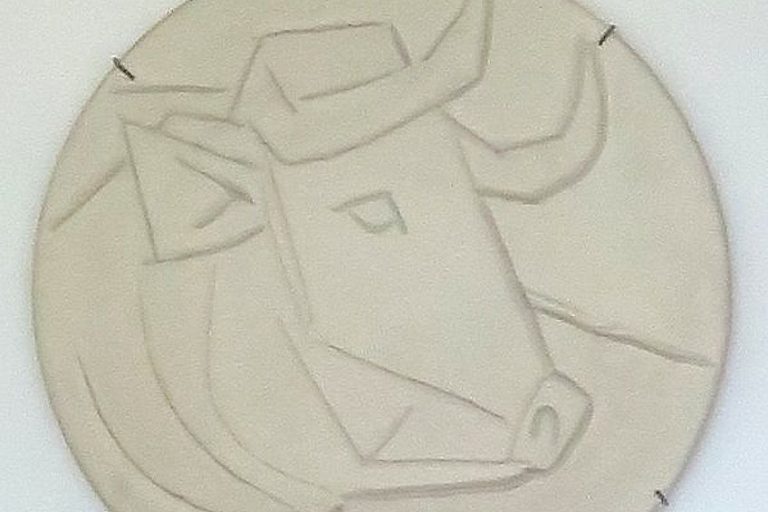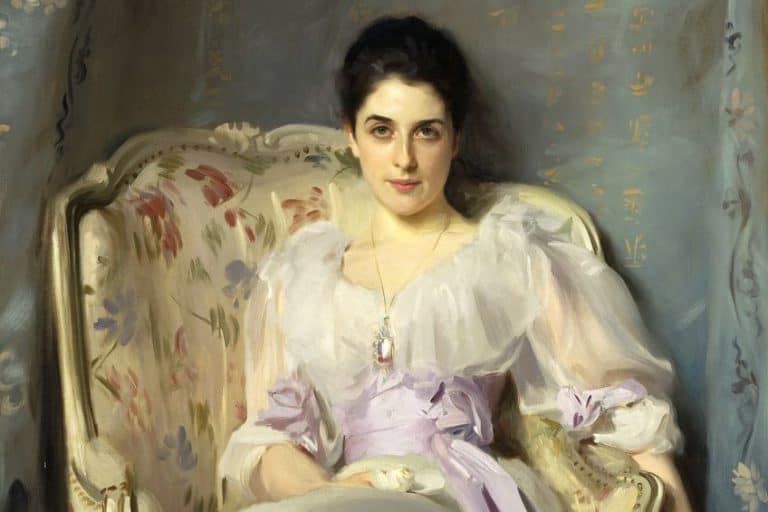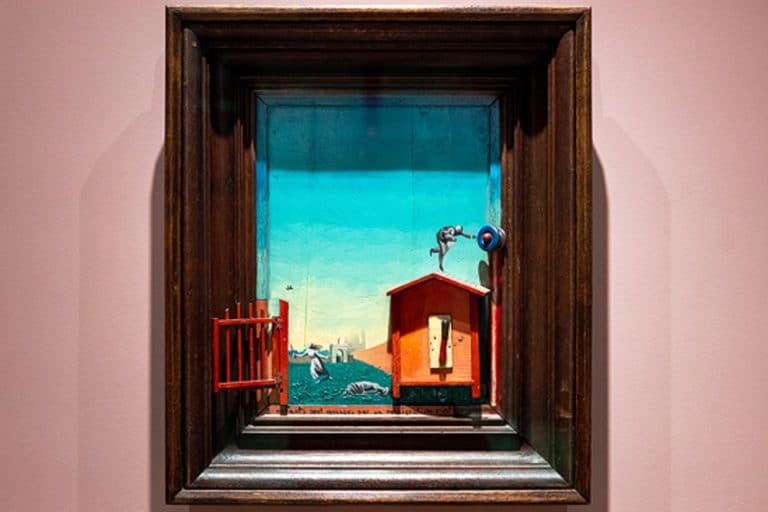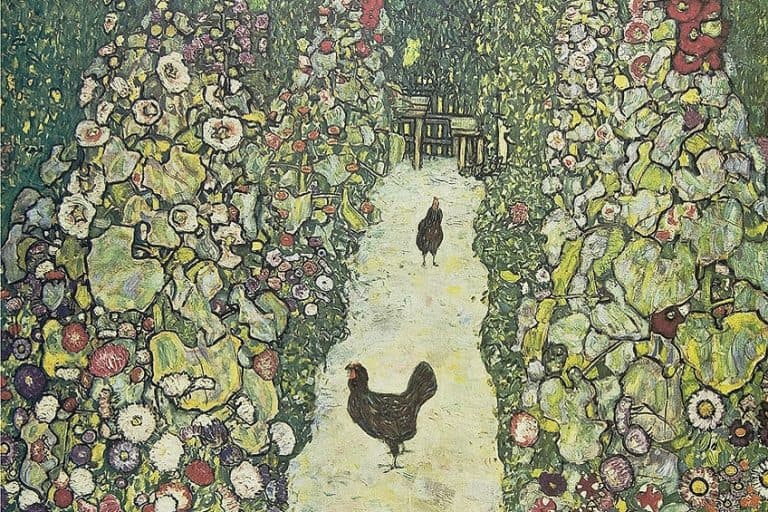“Las Meninas” by Diego Velázquez – A Spanish Painter Art Study
Las Meninas by Diego Velázquez, painted in 1656, is an artwork that still turns heads, reflecting much more than meets the eye and raising seemingly unanswerable questions. This is the painting we will discuss in the article below.
Artist Abstract: Who Was Diego Velázquez?
The Spanish painter Diego Velázquez was born on June 6, 1599 and died on August 6, 1660. He was born in the city of Seville in Spain; his parents were Juan Rodríguez and Jerónima Velázquez. He studied art under Francisco Pacheco and became the court painter for King Philip IV. He lived in Madrid for most of his life and traveled to places like Italy.
Velázquez was known for painting in a naturalistic style and his subject matter included everyday people as well as royal subjects. He influenced numerous artists like Édouard Manet and Salvador Dalí, among others.

Las Meninas (1656) by Diego Velázquez in Context
Las Meninas by Diego Velázquez was one of the more mature artworks by this Spanish painter and his tenure as a court painter. We will provide a Las Meninas analysis below, starting with a brief socio-historic overview of the period Velázquez painted as well as a formal analysis, discussing the painting’s subject matter in finer detail as well as the stylistic techniques utilized.
| Artist | Diego Velázquez |
| Date Painted | 1656 |
| Medium | Oil on canvas |
| Genre | Portrait painting |
| Period / Movement | Baroque art |
| Dimensions (cm) | 320.5 x 281.5 |
| Series / Versions | N/A |
| Where Is It Housed? | Museo del Prado, Madrid, Spain |
| What It Is Worth | Approximately $4 million |
Contextual Analysis: A Brief Socio-Historical Overview
Las Meninas by Diego Velázquez gives an inside peek into the artist’s life as a court painter. It was completed in 1656, which was when the Spanish painter had already been working as a court painter; he started in 1623.
By this time, he had experience painting the king and being around royal subjects, responsible for portraying the king in the highest honor. Furthermore, during his time as a court painter, he was appointed to several positions including the palace chamberlain.
However, it was Velázquez’s wish to become a Knight of the Order of Santiago, which he achieved reportedly three years after he painted Las Meninas. This is a detail evident in the painting, as we will notice the red cross on the artist’s clothing, however, some suggest it was painted on after he was knighted.
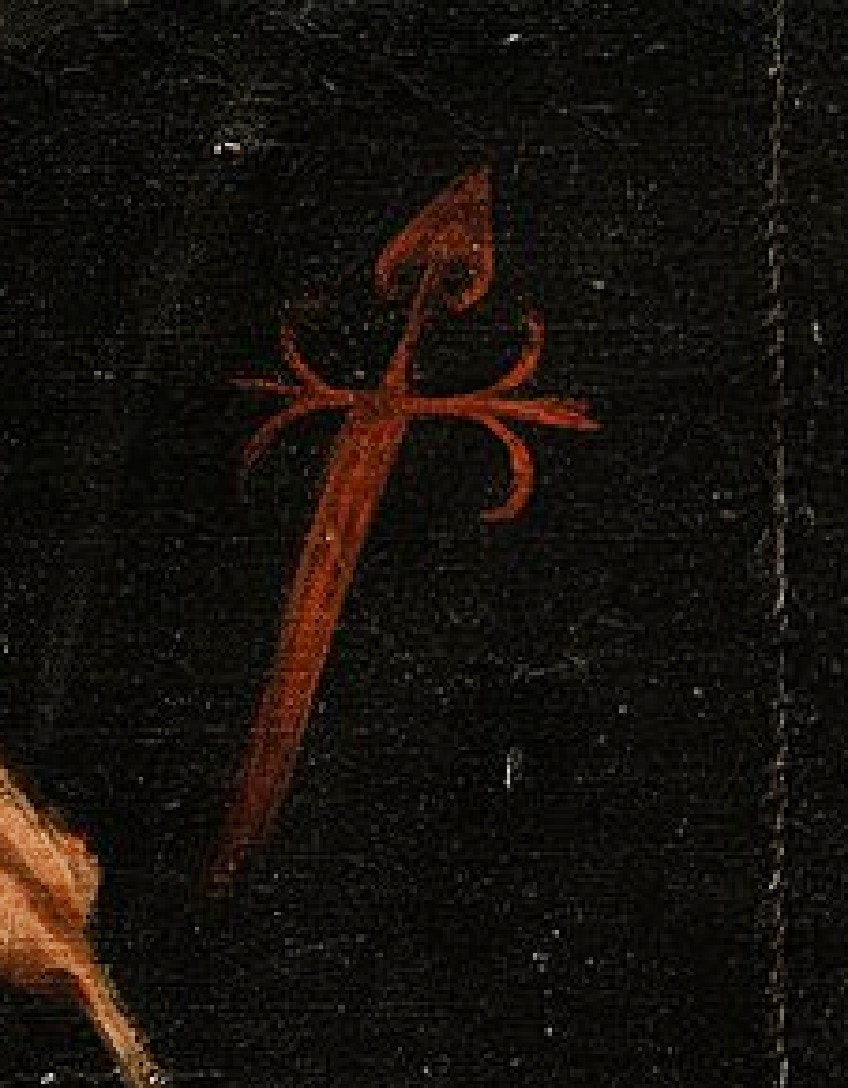
Diego Velázquez painted during the Baroque art movement, which was an art style that emerged during the 16th century in countries like Italy, France, Spain, Germany, and Austria as a result of various religious and socio-political circumstances like the Catholic Church’s Counter-Reformation.
Baroque art was characterized by emotive depth and often appeared with a distinct contrast between dark and light colors to heighten dramatism. It is often described as “ornate” in its style and centers around religious, mythological, or historical themes, which also included royal subject matter.
Velázquez was considered one of the most prominent painters of the Baroque art period and is also known for painting during what was known as the Spanish Golden Age. Apart from his portrait and history paintings, he was known for his naturalistic portrayals of people from all walks of life; two examples among numerous others include Vieja Friendo Huevos (“Old Woman Frying Eggs”) (1618) and The Farmers’ Lunch (c. 1618-1619).

Formal Analysis: A Brief Compositional Overview
The formal analysis below will provide a visual description of the Las Meninas painting as well as a description of Velázquez’s artistic approach according to several art elements, namely, color, texture, line, shape, form, and space. It is important to note here that there has been significant research undertaken towards the Las Meninas analysis to uncover its complexity.
While we will provide an outline of some of its prominent aspects of it, you are encouraged to take the research further and uncover all the connections for a deeper understanding of this Spanish art masterpiece.

Visual Description: Subject Matter
The Las Meninas painting depicts a large interior scene with 11 figures and one dog, which includes the Spanish painter, Diego Velázquez. The scene reportedly takes place in one of the rooms in the Alcázar Palace, which is presently known as the Royal Palace of Madrid.
All the figures appear preoccupied, either in discussion with one another, in deep reflection, or gazing at us, the viewers, with a quiet, almost unnerving, curiosity.
Most of the figures are placed in the foreground, with several in the background. So, let’s begin with the seven figures in the foreground. The central figure around whom most of the interaction seems to be is the Infanta Margaret Theresa, the daughter of King Philip IV and Mariana of Austria. She was reportedly around five years old in this painting.
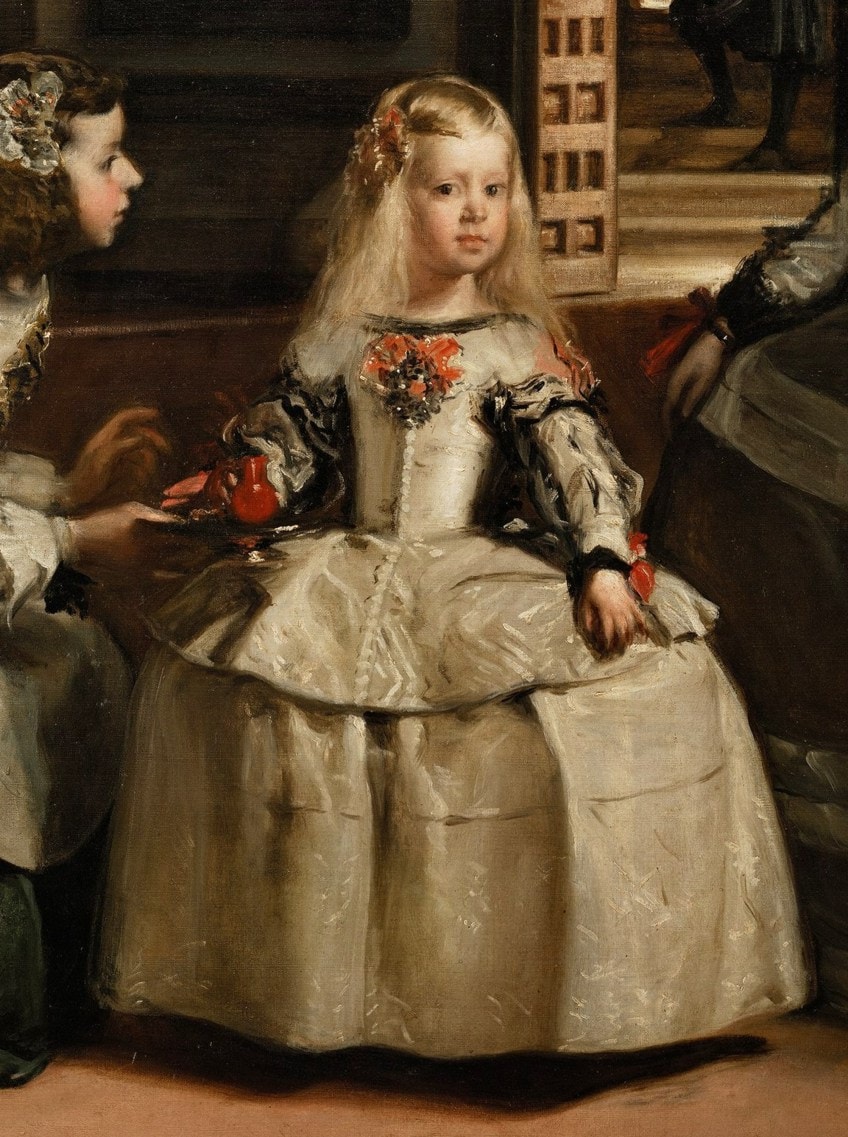
There are two ladies in waiting standing on either side of Infanta Margaret, to her right (our left) is Doña María Augustina Sarmiento de Sotomayor. She is kneeling and holding out a tray with a red clay cup on it in her right hand for Infanta Margaret. The clay cup, or jar, referred to as a búcaro, was commonly utilized for water. To Infanta Margaret’s left (our right) is Doña Isabel de Velasco, who is about to curtsy.
The Spanish word “Meninas” in English translates to “girls”, but the Spanish word “Las Meninas” is mostly understood in the context of “young girls in waiting” or “young ladies in waiting”. They would have been young women who were attendants or assistants to the royal figure, which, in this case, is the young princess.
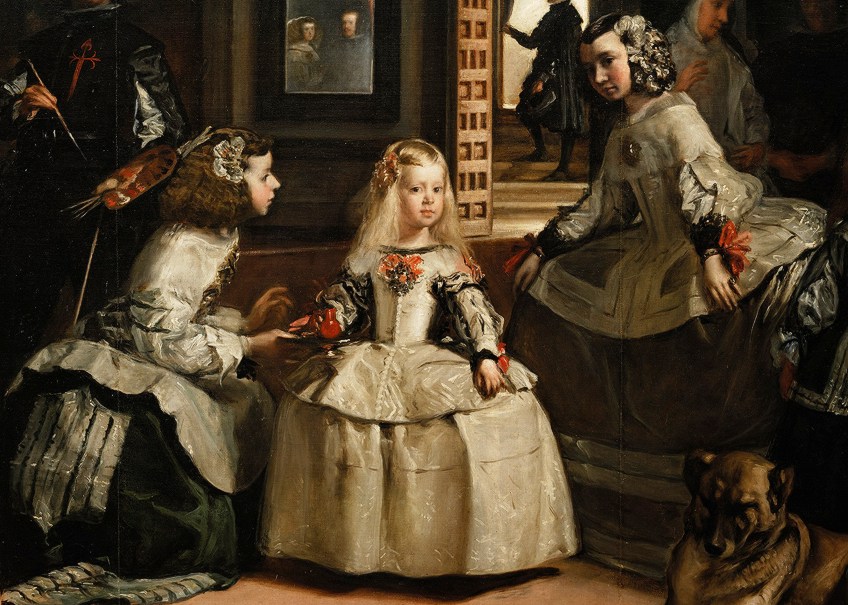
If we move further along to the far right of the composition, two other figures stand to Doña Isabel de Velasco’s left (our right). The first is Mari Bárbola, who was a German and the court dwarf, and to her left (our right) is another dwarf named Nicolás Pertusato, who was an Italian.
A mastiff dog is lying down in front of Bárbola and Pertusato. It appears to be sleeping, although Pertusato’s left foot is on the dog, seemingly playfully trying to wake it or evoke a response from it.

There are two figures standing to the right of the composition, mostly alongside the wall and behind the figures of Doña Isabel de Velasco and Mari Bárbola. To the left is a woman who is talking to a man to her left (our right).
The woman is referred to as Doña Marcela de Ulloa and the man is described as a bodyguard.
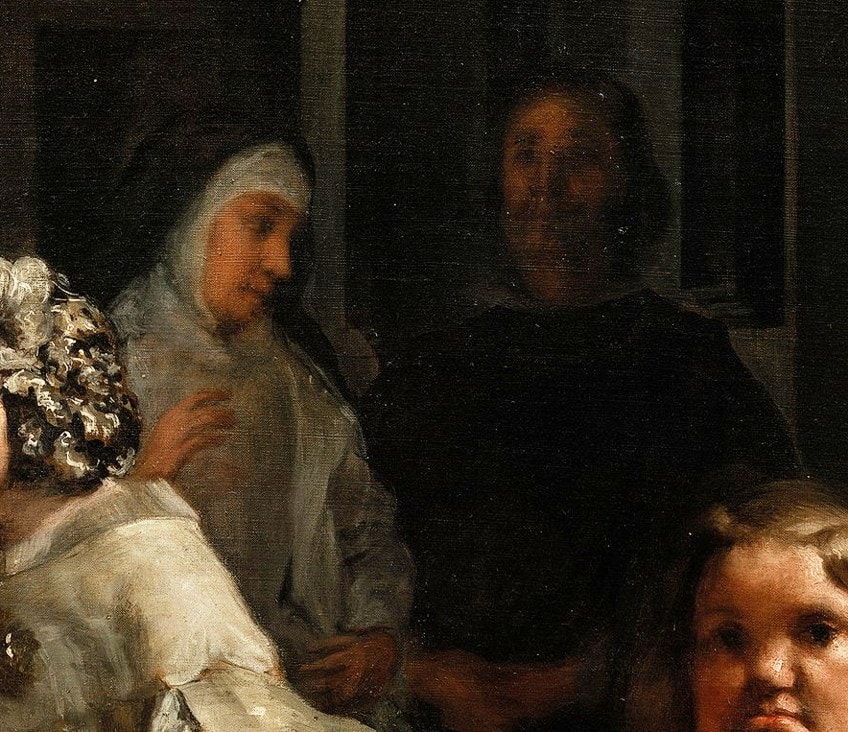
To the far left of the figures in the foreground is a man standing in front of a larger-than-life-size easel with a palette and paintbrush in his hands. He is looking at us, the viewers.
This is Diego Velázquez himself.
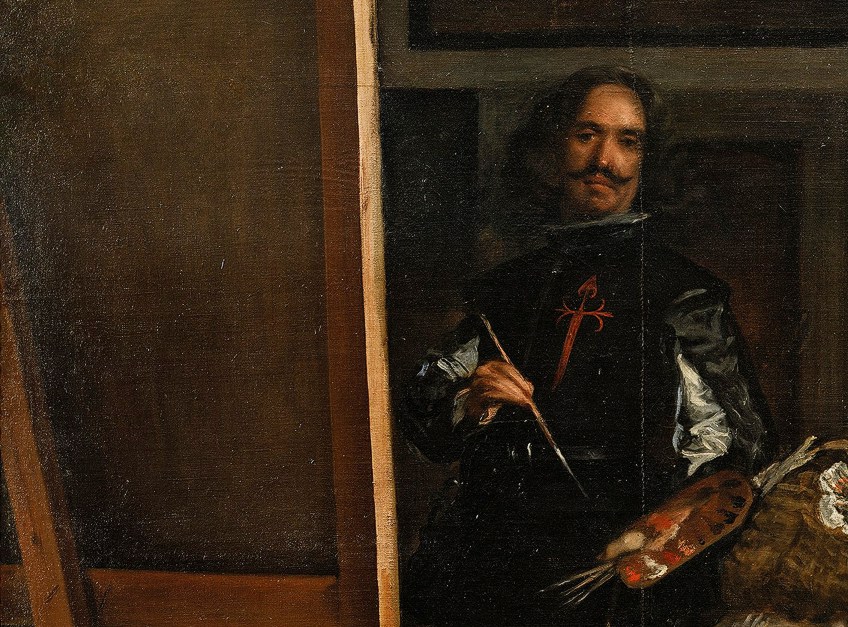
If we look at the background, behind Velázquez is a wall filled with hanging paintings (we also see paintings on the wall to the right). Some of the paintings, notably the two larger paintings above the doorway and the mirror on the back wall, depict scenes from the Roman poet Ovid and his poem Metamorphoses (8 AD).
The scenes were painted by the Flemish artist Peter Paul Rubens.
The painting to the left is reportedly about Minerva who punished Arachne and the one to the right is about Apollo and his victory over Marsyas. It is believed that Velázquez possibly made a reference to Peter Paul Rubens to indicate his connection with the Flemish artist to showcase his artistic skill.
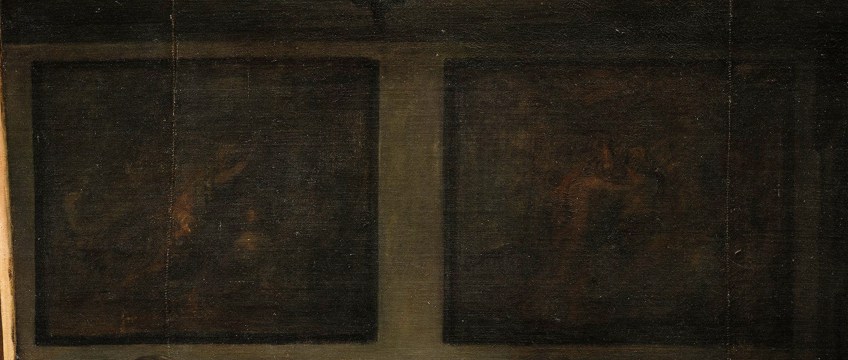
There is also a mirror reflecting two figures who are thought to be King Philip IV and Queen Mariana. Research about the Las Meninas painting has suggested that Velázquez is busy painting their portrait, which means they are sitting in front of the entire scene, seeing it as we are also seeing it.
Furthermore, the figures who are assumedly looking at us, the viewers, could be looking at the king and queen.

There is an open doorway to the righthand side corner in the background opening to a staircase leading to an unknown area outside the room. A man is standing on the steps looking into the interior scene, he is believed to be Don José Nieto Velázquez, who was the chamberlain to the queen. His right hand is holding on to what appears to be a curtain, possibly keeping it open as he looks inside; he is holding his hat in his left hand.
Some sources suggest the ambiguity of his demeanor, whether he is entering the space or about to leave it.
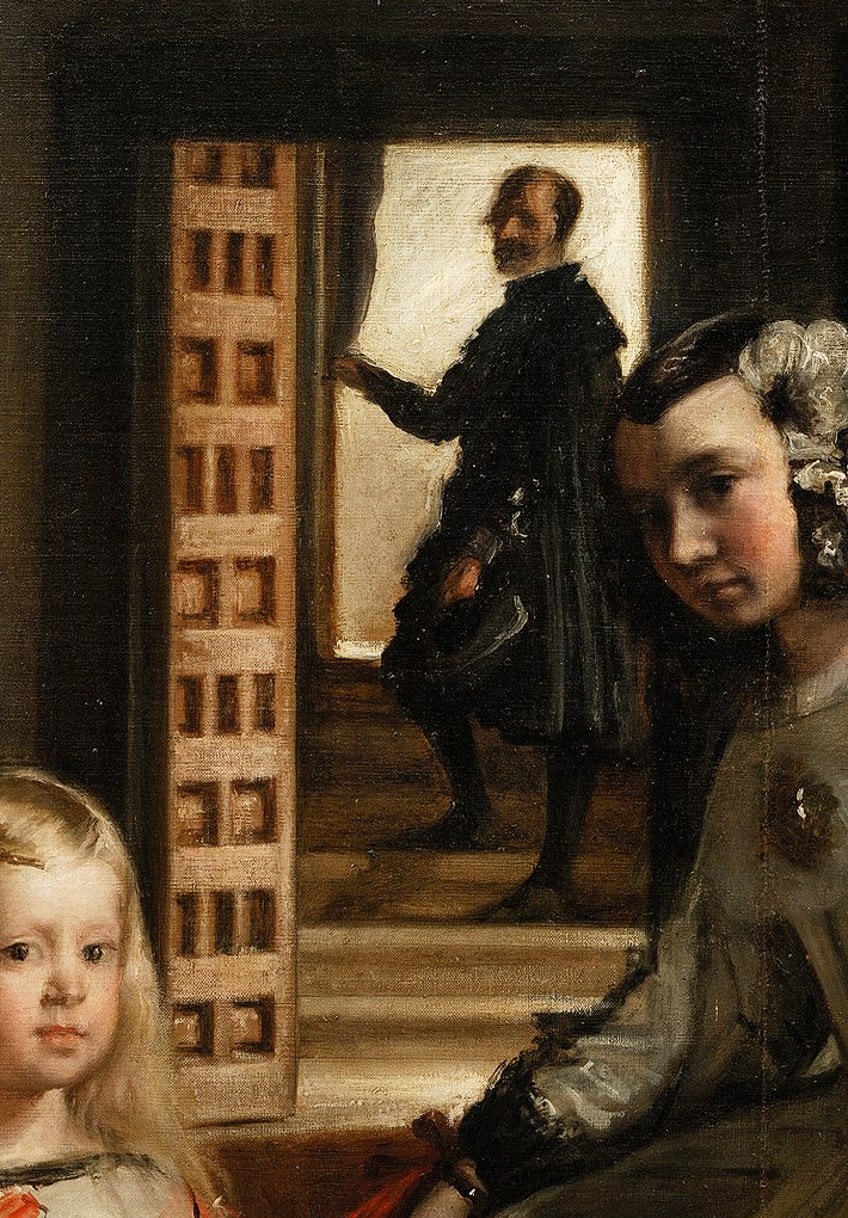
Color
Velázquez utilized a dark color palette for the Las Meninas painting, and there are mostly neutral colors like blacks, browns, and whites with some reds on the flowers worn by several figures, on Infanta Margaret’s dress, and the splashes of color on Velázquez’s palette.
There are also darker green colors on the dresses and skirts of the figures in the foreground. However, according to a pigment analysis done on the Las Meninas painting, the original colors were more blue-green from the azurite pigment. However, due to aging, the colors darkened.
Other pigments Velázquez utilized were charcoal black, bone black, lead white, calcite, brown ochre, yellow ochre, vermilion, smalt, and umber.

There is also a contrast in color value, which is the lightness and darkness of the colors. For example, the lightness of the doorway in the right background creates a silhouetting effect for the man standing in it, who appears dark.
There are two distinct light sources.
The first is to the right and out of our view, where there appears to be a window or windows illuminating the figures in the foreground and seemingly creating more contrast between light and dark as the area behind the figures are dark, placing the two talking figures behind them in shadows.
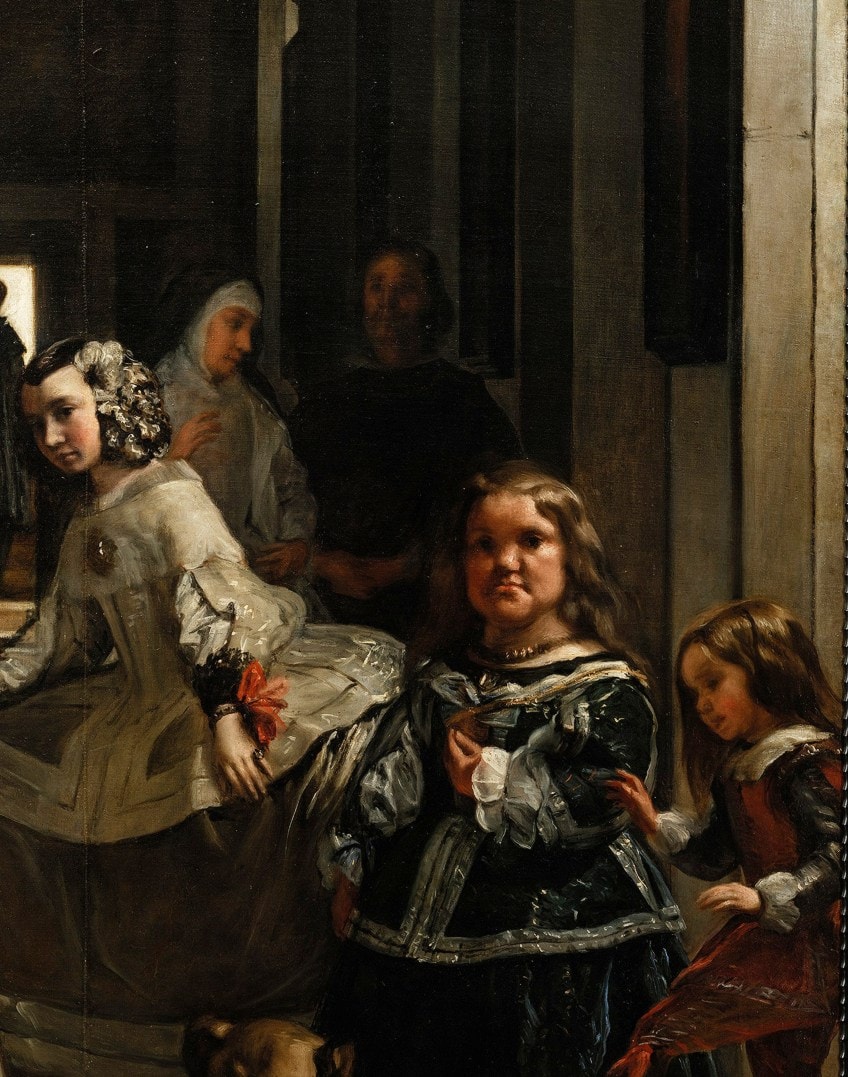
As we move further into the background, the interior becomes lighter because of the open doorway, which allows light in from outside the room, drawing our attention to it. A sliver of lights reaches into the room, breaking up the darkness in the background.
The light and dark areas depict Velázquez’s skill at applying techniques like chiaroscuro; the artistic style of the Italian artist Caravaggio, was reportedly an influence on Velázquez, who would have been exposed to many Italian artists during his travels to Italy.
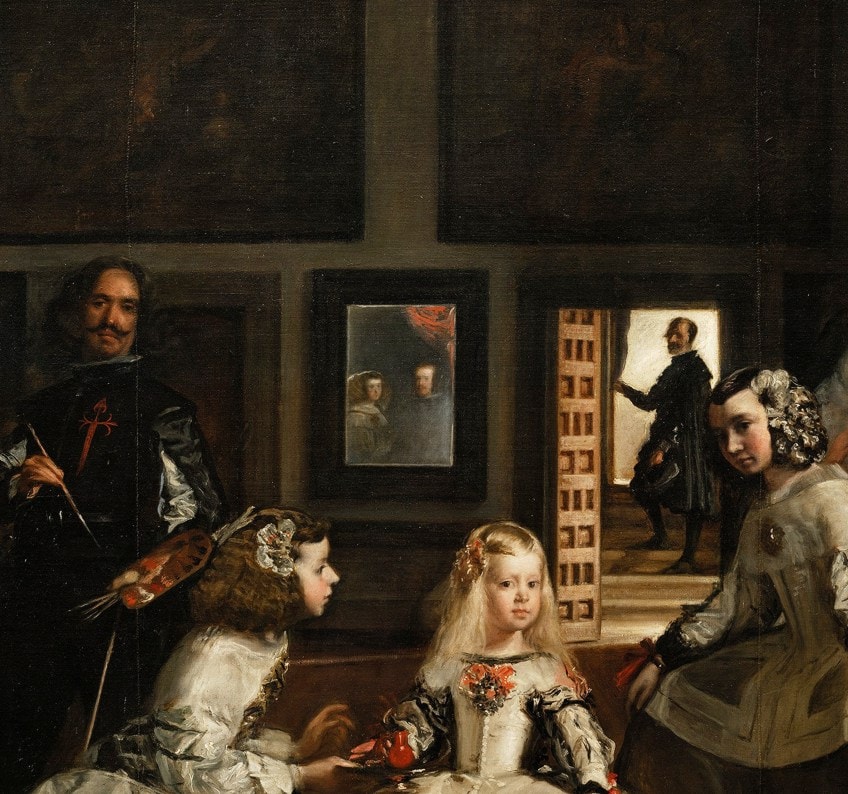
Texture
Diego Velázquez painted in the alla prima technique, which is when wet paint is applied to wet paint, otherwise referred to as “wet on wet”. The name translates to “at first attempt” in Italian. Some art sources have questioned whether Velázquez may have painted this composition in one sitting as the alla prima technique would require.
Due to the “Las Meninas” painting’s size, it could have required more than one sitting to complete, but some art sources suggest that Velázquez could have painted the composition in one sitting and added the details and “touch-ups” afterward.
The brushstrokes vary in the Las Meninas painting; for example, the smooth brushstrokes for the skin, especially on the faces, which contrast with thicker and somewhat looser brushstrokes (Velázquez was known for his loose brushstrokes and influenced many Impressionist painters) for the dresses and skirts as well as the florals.

We will also notice implied texture on the clothing, for example, the finer lace, the silk/satin of the dresses, and the different textures for the figures’ hair especially that of Infanta Margaret, which appears soft and fine as it falls over her shoulders, as well as the soft and short dog’s fur.
An interesting observation about “Las Meninas” and Velázquez’s brushwork is the difference between viewing the composition from afar, which appears skillfully naturalistic, however, when it is viewed up close, the brushstrokes become more evident, and we lose the idea of figurative representation.
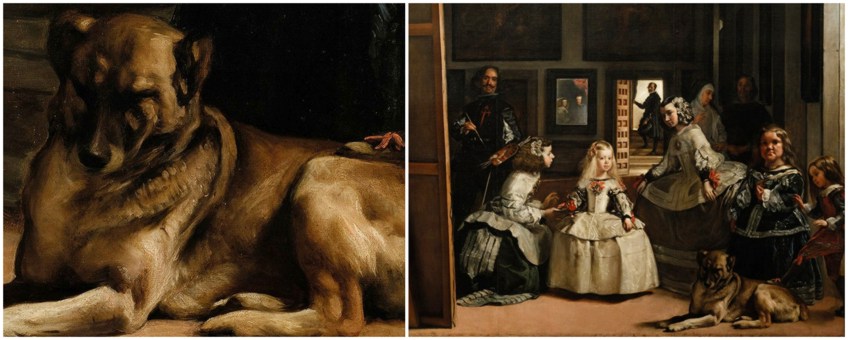
Line
There are several types of lines in the Las Meninas painting, most notably the various horizontal and vertical lines from the paintings hanging in the background, including the large canvas to the left of the scene and the open doorway to the right in the background, which all provide a geometric effect.
This is contrasted with the more fluid and diagonal lines from the figures and their clothing in the foreground.
Implied lines are created to lead our gaze to the focal point of Infanta Margaret. Some examples include the line implied from the kneeling Doña María Augustina Sarmiento de Sotomayor who is directly looking at Infanta Margaret and the seemingly tiered and inward-facing arrangement of the figures to the right leading our gaze to the central figure.

Shape and Form
Like the contrasts of lines in the Las Meninas painting there are also contrasting shapes and forms, which create variety and balance for the overall composition. The background is more geometric with various rectangular and square shapes created by the paintings on the wall, the small squares on the door to the right, the verticality of the stairway, and the mirror on the wall.
The contrast is created by the more organic forms from the figures in the foreground. The naturalistic human form as well as the rounded shapes created by the billowing skirts and dresses worn by the women.
It is also important to note that the various rectangular and square shapes of the painting frames along the walls create a framing effect for the composition, which is further emphasized by the canvas frame to the left, and, as some sources point out, even the interior space creates a frame, situating and framing the figures within their space.
Space
Depth is created through linear perspective. There are several elements and arrangements that lead our gaze, also referred to as the orthogonals, and reportedly the vanishing point is situated where the man is standing in the doorway in the background.
Some of the elements that lead our gaze to the vanishing point include the arrangements of shapes from the hanging paintings on the wall to the right and towards the back as well as the ceiling and its fixtures, which are also in view, creating further open space.
Depth is also created through techniques like overlapping the different shapes and forms, for example, the arrangement of the figures who stand in front and behind one another. Furthermore, depth is shown by portraying the figures at varying scales, for example, the man in the background is smaller in scale than the figures who are closer to our view in the foreground.
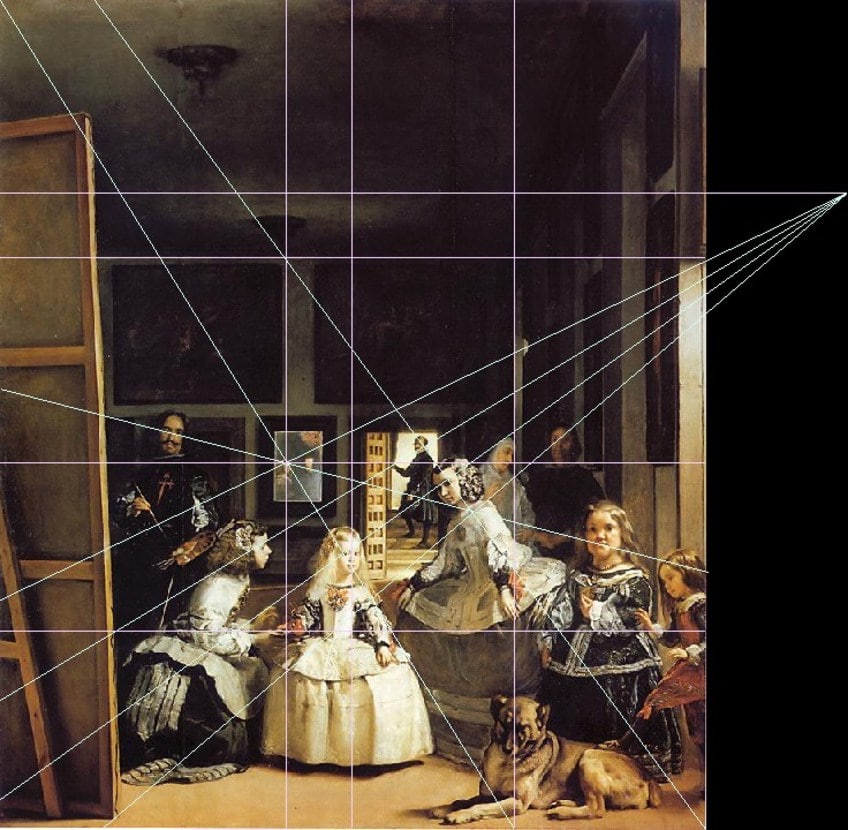
“Mirror, Mirror, on the Wall”
Diego Velázquez creates an intricate space in the Las Meninas painting and there has been extensive research undertaken about it, giving way to an array of interpretations. While his utilization of spatial depth is evident, creating a three-dimensional interior space, the Spanish painter seems to go beyond the physical confines of space by how he plays with implied spaces verging on illusion.
This is best demonstrated by the mirror on the back wall, which seemingly becomes like a window to another space that we, the viewers, cannot see in the composition. Some sources have described it as an “optical illusion” due to the idea that we, the viewers, question our place as the viewer in the composition and what exactly we are seeing.
It leads us to numerous probing questions like, are the king and queen part of the composition? Is the artist painting them in the composition as reflections in the mirror? Are we in the position of the king and queen as the viewers of the scene? Are the figures looking at us, the viewers, or really at the king and queen? Is the king and queen’s reflection hinting at deeper ideas of royalty, becoming more than a mere reflection?
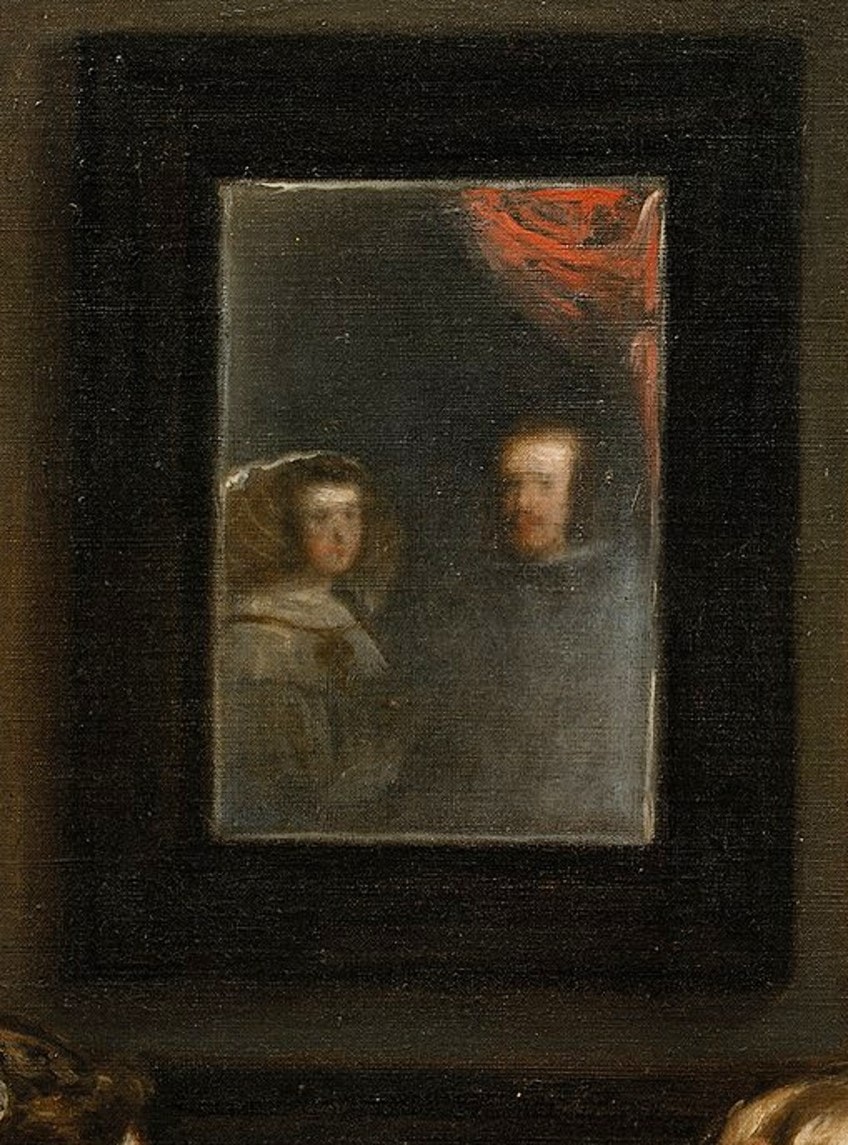
Diego Velázquez was reportedly influenced by the Arnolfini Portrait (1434) by Jan van Eyck, which also depicted a mirror reflecting the figures, however, that mirror was convex and smaller in appearance. It was not as direct as the mirror we see in the Las Meninas painting.
Importantly, the Las Meninas meaning refers to a time when Velázquez painted when ideas about realism and illusion were explored, not only in art but also in literature; for example, in the often-referred novel Don Quixote (Part One was published in 1605, and Part Two in 1615) by the Spanish writer Miguel de Cervantes.
Las Meninas: A Doorway to Deeper Representations
Las Meninas by Diego Velázquez is believed to be one of the exemplary artworks that he created to showcase his artistic abilities that went beyond art as just a mere craft or so-called manual trade, as it was considered during that age. This was also believed to earn his right as a knight for the Order of Santiago, which did not allow tradesmen, and to elevate his reputation as someone who worked in the royal court.
The “Las Meninas” painting takes us on a visual and philosophical journey contained in one room, dedicated to the inner world of royalty. We are looking at a gaze seemingly within a gaze. Velázquez rendered his subject matter with artistic skill and elegance as well as bridged a gap between realism and illusion, as so many have interpreted it. Now, all that is left is this question: What do you see?
Take a look at our Las Meninas painting webstory here!
Frequently Asked Questions
Who Painted Las Meninas?
The Spanish painter Diego Velázquez painted the oil on canvas Las Meninas in 1656. He was the leading court painter for King Philip IV. The painting is set in the interior of the Alcázar Palace in Madrid.
What Is the Las Meninas Meaning in English?
The painting Las Meninas (1656) by Diego Velázquez is titled after the Spanish words that mean the so-called ladies in waiting.
Who Is the Girl in the Las Meninas Painting?
The girl in Diego Velázquez’s Las Meninas (1656) painting is Infanta Margaret Theresa of Spain, who was depicted as her five-year-old self. She was King Philip IV’s daughter, and her mother was Mariana of Austria.
Who Are Reflected in the Mirror in the Las Meninas Painting?
The mirror in the background of the Las Meninas (1656) painting by Diego Velázquez is believed to reflect the figures of King Philip IV and Queen Mariana of Austria. They are believed to be sitting for a portrait painted by Diego Velázquez himself, who is also in the composition, standing to the left.
Alicia du Plessis is a multidisciplinary writer. She completed her Bachelor of Arts degree, majoring in Art History and Classical Civilization, as well as two Honors, namely, in Art History and Education and Development, at the University of KwaZulu-Natal, South Africa. For her main Honors project in Art History, she explored perceptions of the San Bushmen’s identity and the concept of the “Other”. She has also looked at the use of photography in art and how it has been used to portray people’s lives.
Alicia’s other areas of interest in Art History include the process of writing about Art History and how to analyze paintings. Some of her favorite art movements include Impressionism and German Expressionism. She is yet to complete her Masters in Art History (she would like to do this abroad in Europe) having given it some time to first develop more professional experience with the interest to one day lecture it too.
Alicia has been working for artincontext.com since 2021 as an author and art history expert. She has specialized in painting analysis and is covering most of our painting analysis.
Learn more about Alicia du Plessis and the Art in Context Team.
Cite this Article
Alicia, du Plessis, ““Las Meninas” by Diego Velázquez – A Spanish Painter Art Study.” Art in Context. October 11, 2022. URL: https://artincontext.org/las-meninas-by-diego-velazquez/
du Plessis, A. (2022, 11 October). “Las Meninas” by Diego Velázquez – A Spanish Painter Art Study. Art in Context. https://artincontext.org/las-meninas-by-diego-velazquez/
du Plessis, Alicia. ““Las Meninas” by Diego Velázquez – A Spanish Painter Art Study.” Art in Context, October 11, 2022. https://artincontext.org/las-meninas-by-diego-velazquez/.





